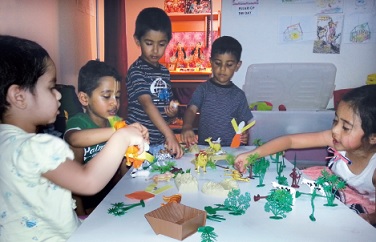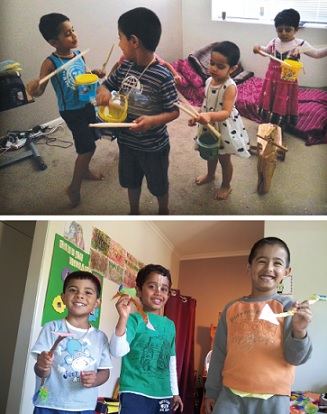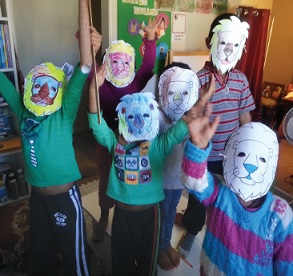
Introducing Krishna consciousness to young children through play.
In one corner of my preschool room, two four-yearold boys are pretending to be Krishna and Balarama. Tying shiny scarves on their heads and waists, they wrestle with an imaginary Dhenukasura. In another corner, a three-year-old girl is playing with wooden blocks. She stacks them up to make a temple. Enthusiastically, she shows me the altar and the temple hall. Near the bookshelf, a fourth child is reading Dr. Edith Best’s books with the pre-recorded reading device. Chants of om namo bhagavate vasudevaya fill the room. I smile. For me, this is Vrndavana.
The preschool age is wonderful because children start exploring and understanding the world they live in. They begin to communicate thoughts, ideas, and emotions. They are eager to learn and absorb new words, new skills, and new ideas.
Unfortunately, with today’s hectic lifestyle, parents feel they don’t have the time to meaningfully engage children of this age group. They are too young to go to school full time. They don’t have the attention span for long periods of academic learning. Playgroup lasts for only about half the day, and for the remaining time the bored and unoccupied child may end up in front of the television or computer screen. Even if the child is playing, undirected play means the child constantly seeks new stimulation.
He plays with one toy for some time and then discards it for another, eventually getting bored and tired.
Moreover, the limited time in human life is being wasted. Human life is rare and precious, and the advanced intelligence given to humanity is meant to be used for God consciousness and selfrealization. In fact, spiritual life must be started from the earliest possible age so that the child grows up being aware of his duties as an eternal spiritual soul. In the Srimad- Bhagavatam (7.6.1), the great devotee Prahlada teaches his friends, “One who is sufficiently intelligent should use the human form of body from the very beginning of life – in other words, from the tender age of childhood – to practice the activities of devotional service, giving up all other engagements.”

Hence young children need to be meaningfully occupied in God consciousness by engaging them in games and activities centered on Krishna . I have the opportunity to teach children in a Krishna conscious preschool in my home in Melbourne, Australia, and have seen the spiritual growth and positive impact on behavior and learning that a God-conscious environment has on the minds of young children. Such an environment can be created without much effort at home.
Introducing Krishna Conscious Routines
Children thrive on routines. Routines make them feel secure because they know what to expect. They also help the children build confidence as they gradually master through regular practice the skills the routines require. Hence it is never too early to establish Krishna conscious routines.
Preschoolers can be introduced to a simplified morning routine to mimic what they might experience at an ISKCON temple. They can perform a simple arati to the deity, or to a Krishna doll, and circumambulate Tulasi Devi for Tulasi-püja. At my preschool, the children hold hands and walk around Tulasi Devi, ring-around-the-rosey style, singing, “Here we go ’round the tulasi tree” to the tune of “Here we go ’round the mulberry bush.” Then we all sit down and chant Hare Krishna together – one round of japa on a strand of twenty-seven beads. This is followed by an energetic gurupüja kirtana in which the children play karatalas and jump and dance enthusiastically.

The children present the Nrsimha masks they colored while learning about Lord Krishna’s ten pastime incarnations.
I introduced this routine gradually, adding one new item each day over a week. Initially, the children were slow to fully participate, singing softly and chanting distractedly. But as the children kept doing the routine daily, with my encouragement and appreciation for every success, they became more enthusiastic. They now participate without reservation. They chant japa loudly, with backs straight and eyes closed.
I also have prasada routines, during which the children say prasada prayers together before honoring prasada. While eating, they listen to a recorded reading of the children’s version of Srila Prabhupada’s “Krishna Book.” This routine has helped to make teaching prasada etiquette very easy. They do not talk or run around during meals, because they are absorbed in listening to the story.
Exploring Krishna ’s Pastimes Through Crafts
Preschoolers love arts and crafts. Not only does this sort of activity give them an outlet for their creativity and imagination, it also helps build hand-eye coordination and fine motor skills, important foundations for future academic study. And dovetailing creativity with Krishna consciousness can be an enriching devotional experience for a child.
At my preschool, I connect each craft to the “pastime of the day.” For example, while studying the Ramayana we use sand and blue, green, and golden glitter paint to create the bridge between India and Sri Lanka. Similarly, we make Nrsimhadeva masks and paperbowl tortoises while studying the Dasavataras, and stick arrows and paper-bag demon puppets while reading the Mahabharata. These projects not only enable the children to understand the pastimes more deeply but also give them Krishna -related toys to play with. They automatically use the toys to reenact the Lord’s pastimes in their play and are thus fully absorbed in Krishna consciousness.
The crafts need not be complicated; in fact, they must be simple so that the children can complete them themselves and feel successful. A few readily available materials like cardboard, colored paper of different types, scissors, glue, paint, and foam cups and bowls can help children create their versions of beautiful devotional paraphernalia.
Krishna in Sound
Have you ever wondered why we don’t forget our childhood nursery rhymes? It’s due to the power of the brain at the tender ages of three to six. During this period, the brain is as impressionable as wet cement – any input becomes hardened for life. Hence it is critical to give children devotional songs and prayers early on. They will remember them for the rest of their lives.
There is a wealth of Krishna conscious rhymes and songs made specifically for little children. Most of these are available freely on kids. iskcondesiretree.info. Apart from these songs, I also practice Sanskrit verses and bhajanas with the kids. There are many simple bhajanas that children can easily pick up, like “Vibhavari Sesa” or “Krishna Jinka Nam Hai.” Sanskrit can also be introduced through mangalacarana prayers or the verses of the Brahmasamhita or Sri Siksastaka. When I repeat Sanskrit prayers daily and progress slowly, one verse at a time, the children absorb them quickly and easily. You will be amazed at how fluently they soon start reciting them.
Krishna Conscious Toys
There is a wide selection of Krishna conscious toys being made by devotees. Soft toys, action figures, puzzles, and wooden dolls are all available. It is important to create an environment that allows the children to introduce Krishna into their play. For example, we can give them manipulative toys that allow them to recreate the devotional life they see around them. Wooden and Lego blocks and figurines of animals or people can be given for openended construction and imaginative play. Children will use them to make temples, Jagannatha carts, and Vrndavana scenes. Similarly, modeling clay allows children to “cook” rotis, cookies, cakes, and vegetables for Krishna . If arati paraphernalia, decorative cloth, and beaded jewelry are kept around, children will use them to decorate and worship Krishna dolls. And keeping shiny cloth in blue, yellow, and red along with craft feathers and other decorations will give them a chance to dress up like Krishna or the cowherd boys and girls.
Sometimes adults may need to model the use of these props in a Krishna conscious manner to encourage children to bring Krishna into their games. But if children are growing up in Vaisnava culture, they may automatically use these toys to imitate the adults around them.
It is a child’s great fortune to have been born in a Vaisnava family. The spark of Krishna consciousness, preserved from previous lifetimes, is already there in that fortunate soul’s heart. With a little fanning from adults, natural love for Lord Krishna can ignite. Both children and adults can then take joy in the increasing devotional mood of the family.
Suvarna Radhika Devi Dasi has been practicing Krishna consciousness for the last fifteen years. She is a software engineer and a Bharat Natyam dancer and has certification in childcare. Visit her blog: kanhaspreschool.blogspot.com.au.
